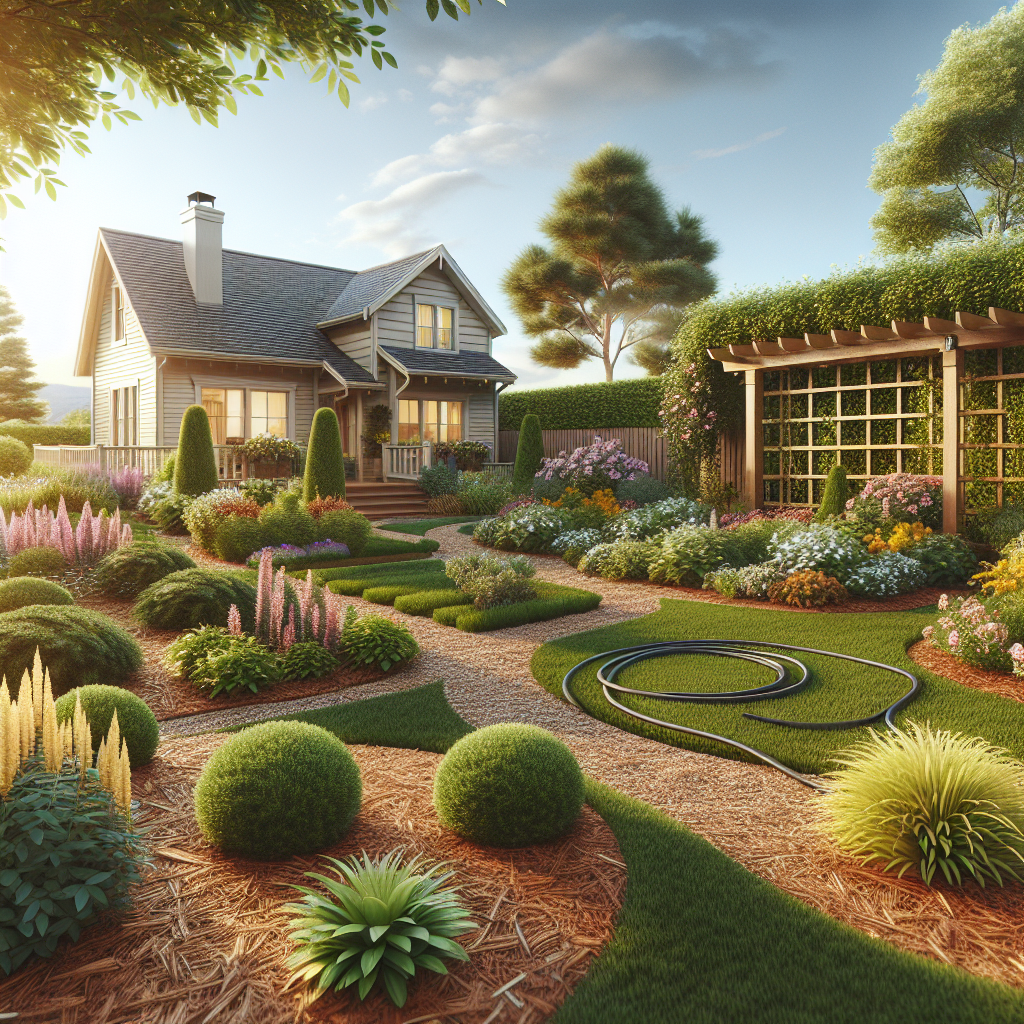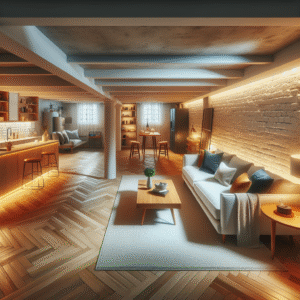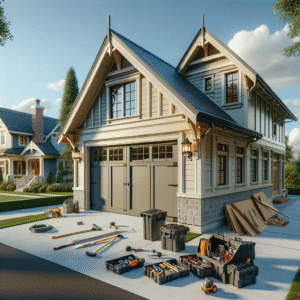Creating a low-maintenance garden is not just about simplifying your gardening routine but also about embracing a lifestyle of minimal upkeep and maximum enjoyment. Whether you’re a busy professional, a family on the go, or someone who prefers spending leisure time in nature rather than maintaining it, understanding the fundamentals of a low-maintenance landscape can transform your outdoor space into a beautiful yet functional haven.
Choosing the Right Plants for a Low-Maintenance Garden
Start by selecting plants that are well-suited to your local climate and soil conditions. Opt for native species as they are more likely to thrive with minimal intervention. Perennials like sedum, lavender, and ornamental grasses not only add color and texture to your garden but also require less water and fewer fertilizers than their annual counterparts. Incorporating drought-resistant plants can also reduce watering needs, making your garden more sustainable and easier to care for.
Implementing Durable Hardscaping and Mulching Techniques
Hardscaping elements such as stone paths, patios, and retaining walls provide structure and reduce the area that requires active gardening. These permanent features offer a practical yet aesthetically pleasing framework that stands the test of time. Mulching is another effective strategy; it helps retain soil moisture, suppress weeds, and enrich the soil as it decomposes. Opt for organic mulches like bark or straw, which provide nutrients and enhance the garden’s overall health.
Utilizing Modern Irrigation Systems for Effortless Gardening
Modern irrigation systems, such as drip irrigation or soaker hoses, target water directly to the roots where plants need it most. This not only conserves water but also promotes healthier plant growth by reducing surface wetness and preventing leaf diseases. Consider installing a timer or a smart irrigation controller that adjusts watering based on weather conditions, ensuring that your garden receives the right amount of water without any wastage.
By integrating these elements, you can create a stunning garden that requires minimal effort to maintain, giving you more time to enjoy the beauty of your outdoor space. Follow these tips and transform your garden into a low-maintenance, sustainable retreat that thrives year-round.

If you’re ready to take your home improvement or construction project to the next level, we can help! Find trusted contractors on BuildNet, whether you’re looking for renovations, new builds, electrical work, plumbing, or anything in between. Our directory connects you with qualified professionals who can make your vision a reality.
Choosing the Right Plants for a Low-Maintenance Garden
Hey there, green thumbs and gardening enthusiasts! If you’re anything like me, you adore a lush, blooming garden but might not have all the time to dedicate to its upkeep. Fear not, because today we’re diving into the world of easy-care plants that will transform your garden into a hassle-free oasis. Whether you live in the sunny tropics or the cooler climes, there’s a low-maintenance plant waiting just for you. Let’s get started on creating a beautiful garden that practically takes care of itself!
Understanding Your Local Climate and Soil
First things first, to pick the right plants for your garden, you need to understand your local climate and soil type. This isn’t as daunting as it sounds! A simple way to get this info is by checking with your local gardening center or cooperative extension service. They can provide insights into which plants thrive best in your area. Remember, choosing plants adapted to your environment reduces the need for water, fertilizers, and pesticides, making your gardening both easier and more sustainable.
Top Low-Maintenance Plants for Various Climates
Now, let’s talk plants! Here are some star performers that are known for their resilience and minimal need for care.
For Cooler Climates
- Hostas: These shade-loving perennials are perfect for low-light gardens and come in a variety of sizes and leaf colors.
- Sedum (Stonecrop): A hardy succulent that thrives in poor soil and requires little watering.
- Daylilies: Known for their vibrant blooms and ability to survive with minimal fuss, daylilies are a colorful addition to any garden.
For Warmer Climates
- Lavender: Not only does this plant have a heavenly scent, but it’s also drought-resistant and loves the heat.
- Palms: If you’re looking for a tropical vibe, various palms are incredibly low-maintenance and add instant impact to your landscape.
- Agave: With its striking form and minimal water needs, agave is perfect for xeriscapes and dry conditions.
Choosing Drought-Tolerant Plants for Water Conservation
In many regions, water conservation is a significant concern. Opting for drought-tolerant plants not only makes your garden easier to maintain but also helps save our precious water resources. Plants like succulents, cacti, and many native grasses thrive in dry conditions and can go long periods without watering. Plus, they add unique textures and interest to your garden design!
Natives are Natural Winners
When in doubt, go native! Native plants are a superb choice as they are adapted to the local climate and soil conditions. This means they’re more disease-resistant and require less pampering than non-natives. Some fantastic native plants include:
- Coneflower (Echinacea): This native wildflower not only looks beautiful but also attracts pollinators like bees and butterflies.
- Switchgrass: A native ornamental grass that adds movement and grace to your garden scape.
- California Poppy: If you’re in the West, the California poppy offers dazzling orange blooms that are a delight to behold.
Evergreens: The Year-Round Champions
For those who desire greenery all year round, evergreens are the way to go. These plants keep their leaves throughout the seasons, which means consistent coverage and less bare patches in your garden during off-seasons. Choices like boxwood, holly, and various types of juniper offer great versatility and require minimal upkeep once established.
Perennial Power
Perennials are the gifts that keep on giving. Plant them once, and they will bloom year after year. While some might need a little pruning or the occasional division, generally, perennials like salvia, asters, and bellflowers are workhorses that will beautify your garden with much less effort than their annual counterparts.
There you have it, friends! With these tips, you can choose the right plants that will thrive in your local garden without demanding too much of your time. Remember, the goal is to enjoy your garden, not to become its servant. Happy gardening, and may your thumbs always be green!

Implementing Durable Hardscaping and Mulching Techniques
Hey there! If you’re looking to enhance your garden’s appeal while cutting down on maintenance, you’re in the right place. Today, let’s dive into the world of durable hardscaping and effective mulching. These techniques are not only time savers but can also significantly boost the curb appeal of your property—something we all crave, right?
Understanding Hardscaping: A Solid Foundation
First off, hardscaping involves the non-living elements of your garden: things like patios, walkways, and retaining walls. Choosing the right materials and designs can create a timeless and durable outdoor space. Let’s break it down:
- Stone: Natural stone offers a robust, classic look that ages beautifully. Granite, slate, and limestone are popular choices for their durability and natural appearance.
- Pavers: Available in a variety of materials like concrete and clay, pavers are excellent for creating patterns and intricate designs. They’re also easy to replace if damage occurs.
- Concrete: A more budget-friendly option, concrete can be stamped or colored to add a unique flair to your garden paths or patios.
When planning your hardscape, consider the overall flow of your garden. For instance, curved pathways can create a more relaxed, natural vibe, while geometric designs enhance a modern aesthetic. Also, integrating permeable paving options can help manage stormwater runoff, keeping your garden more sustainable.
Mastering Mulching: More Than Just Aesthetics
Mulching is a superhero in the garden. It conserves moisture, suppresses weeds, and as it decomposes, it provides valuable nutrients to your plants. Here’s how to get the most out of mulching:
- Organic Mulches: These include materials like bark chips, straw, and grass clippings. They improve the soil’s fertility as they decompose but will need to be replenished periodically.
- Inorganic Mulches: Gravel, pebbles, and rubber mulch fall into this category. They don’t improve soil structure but are excellent for permanent solutions in areas like walkways or driveways.
Tip: When applying mulch, aim for a layer about 2-3 inches thick. This is enough to be effective without suffocating your plants. Also, keep the mulch a few inches away from plant stems to prevent rot.
Combining Hardscaping and Mulching for Optimal Results
Now, combining these two elements might seem straightforward, but it’s where art meets science in your garden. Here are a couple of tips to ensure they complement each other perfectly:
- Visual Harmony: Choose mulches that complement your hardscaping materials. For instance, brown bark mulch looks fantastic next to red brick paths, offering a cohesive aesthetic.
- Functional Spaces: Design your hardscapes, such as paths or patios, to handle foot traffic and heavy use, while mulched areas can be reserved for moisture retention and visual interest around plantings.
Remember, the goal is to create a garden that’s not only beautiful to look at but also functional and easy to maintain. With sturdy hardscaping underfoot and nutrient-rich mulch nurturing your plants, your garden will be equipped to thrive with minimal intervention.
Local Inspiration
Don’t forget to take a local approach! Visit nearby gardens, or even better, consult with local landscaping professionals. They can offer insights into what materials and mulch types work best in your area’s climate and soil type, which can be a game-changer for your gardening success.
So, whether you’re looking to install a new garden pathway or revamp your current mulching strategy, these tips should guide you towards creating a more sustainable and beautiful garden. Happy gardening!
Utilizing Modern Irrigation Systems for Effortless Gardening
Hey there, green thumbs and gardening enthusiasts! Are you looking for a way to keep your garden lush without spending every spare minute with a hose in hand? Modern irrigation systems might just be your new best friend. Not only do these systems save time, but they also conserve water and ensure your plants get the precise hydration they need to thrive. Let’s dive into how these systems can transform your gardening experience, making it as effortless as possible.
Understanding the Basics of Modern Irrigation Systems
Before we get into the nitty-gritty, let’s cover what a modern irrigation system actually entails. Essentially, it’s a method to automate the watering process of your garden. From drip irrigation to sophisticated sprinkler systems, these setups can be tailored to suit the specific needs of your garden, no matter the size or type.
- Drip Irrigation: Perfect for targeted watering, allowing water to slowly drip to the roots of plants.
- Sprinkler Systems: Ideal for covering larger areas, sprinklers can be adjusted to spray in any direction.
- Soaker Hoses: These hoses allow water to seep out all along their length and are great for rows of plants.
Each type has its unique benefits, and the best choice depends on your garden’s layout and your specific gardening goals.
Choosing the Right System for Your Garden
Picking the right irrigation system doesn’t have to be complex. Consider the following factors:
- The size of your garden: Larger gardens might benefit from a sprinkler system, whereas smaller or more segmented gardens could be better served by drip or soaker hose systems.
- Type of plants: Different plants require different amounts of water. Drip systems can be very effective for precise watering directly to the plant roots, minimizing waste.
- Your local climate: If you live in an area with frequent rain, your needs will be different from someone in a drought-prone zone.
Consulting with a local expert can also provide insights tailored to your specific environmental conditions, enhancing your garden’s potential.
The Installation Process
Think installing an irrigation system is too complex? Think again! Many local contractors specialize in quick and efficient installations. Here’s a general idea of what to expect:
- Planning: The contractor will evaluate your garden and plan the layout of the system, ensuring optimal coverage and functionality.
- Installation: This step involves laying out the pipes and sprinklers or drip lines according to the plan. It can typically be completed within a few days, depending on the garden’s size.
- Testing and Adjustments: After installation, the system is tested, and adjustments are made to ensure every plant gets the hydration it needs.
With professional installation, you avoid the common pitfalls of DIY projects, such as uneven water distribution or unnecessary water waste.
Benefits of Automated Irrigation
Once your system is up and running, you’ll quickly see why so many gardening enthusiasts are making the switch:
- Time-saving: Set your watering on a timer—say goodbye to early mornings spent watering the garden by hand.
- Water efficiency: Modern systems are designed to minimize waste. This not only helps the environment but can also reduce your water bill.
- Better plant health: By delivering water directly where it’s needed, these systems reduce the chances of diseases that are common with overwatering.
The joy of gardening shouldn’t be overshadowed by maintenance chores. With an automated irrigation system, your garden care becomes more about enjoying the blooms and less about battling with the hose.
Maintaining Your Irrigation System
Like any other system, your garden’s irrigation setup needs regular check-ups to perform at its best. Here are a few tips:
- Regular inspections: Check for leaks, blocked nozzles, or any signs of wear and tear.
- Seasonal adjustments: Update your watering schedules based on seasonal weather changes.
- Professional audits: Have a professional check your system annually to ensure it’s running efficiently.
Maintaining your system might seem like a bit of a chore, but it’s a small price to pay for the beauty and yields of a well-tended garden.
Ready to Upgrade?
If you’re considering upgrading to a modern irrigation system, you’re embarking on a journey toward a more sustainable and enjoyable gardening experience. Remember, the key to a thriving garden is not just the care you put into it but also the tools you use. So, why not let technology do the heavy lifting while you reap the rewards?
Happy gardening!

What are the best low-maintenance plants for my garden?
Choosing low-maintenance plants is key for a thriving garden that doesn’t require constant care. Consider native plants, as they are well-adapted to your local climate and soil conditions, meaning they require less watering, fertilizing, and pest control. Perennials like sedum, lavender, and hostas are great choices since they come back year after year and require minimal upkeep. Succulents and ornamental grasses are also excellent for their drought resistance and overall hardiness.
How can hardscaping improve my garden’s sustainability and ease of maintenance?
Hardscaping involves the addition of non-living elements like stone walls, pathways, and patios to your garden. These features not only add aesthetic value but also reduce the amount of area that needs regular maintenance. Using durable materials like concrete, natural stone, or recycled composites ensures longevity and reduces the need for replacements. Strategically placed hardscaping can help control erosion and manage water flow in your garden.
What are the benefits of using mulch in my garden?
Mulch is not only aesthetically pleasing but also a gardener’s best friend when it comes to reducing maintenance. It helps retain soil moisture, suppress weeds, and regulate soil temperature. Organic mulches, such as wood chips or straw, additionally enrich the soil as they decompose. Remember to reapply organic mulch annually to maintain its benefits.
Can modern irrigation systems save time in garden maintenance?
Definitely! Modern irrigation systems, such as drip irrigation or soaker hoses, are designed to deliver water directly to the base of the plant, which minimizes evaporation and wastage. Automated systems can be set on timers to water your plants at optimal times of the day, which not only saves water but also frees up your time. Investing in a good irrigation system can significantly reduce the labor involved in keeping your garden lush and healthy.
How do I choose the right contractor for installing a garden irrigation system?
Choosing the right contractor is crucial for a successful installation. Look for licensed professionals with experience in garden irrigation systems. Check reviews and ask for references to assess their reputation and reliability. A knowledgeable contractor will consider factors like water pressure, the types of plants in your garden, and your local climate to customize the irrigation system to your garden’s specific needs.
Are there eco-friendly options for garden hardscaping and mulching?
Yes, there are several eco-friendly options available for both hardscaping and mulching. For hardscaping, materials like reclaimed wood, recycled plastic, and permeable paving options help reduce environmental impact. For mulching, organic materials like cocoa shells, pine needles, or compost offer a sustainable choice, enhancing soil health while keeping your garden looking great.
Conclusion
We hope this FAQ has shed some light on how you can create and maintain a beautiful garden with minimal effort. Remember, choosing the right plants, implementing effective hardscaping, using mulch wisely, and installing a modern irrigation system can significantly reduce your gardening workload. If you’re thinking about upgrading your garden but need some professional advice or assistance, don’t hesitate to reach out to a contractor on the BuildNet website. They offer free quotes and can help you design a low-maintenance garden that suits your needs and preferences. Happy gardening!







